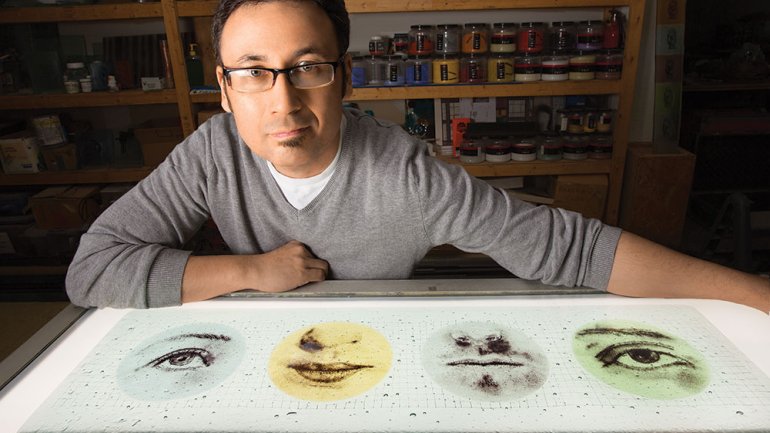Becoming Michael Janis
Becoming Michael Janis
Before Michael Janis was a glass artist, he was an architect giving his glass supplier a very hard time.
He remembers one particularly frustrating project, when he was trying to design glass partitions for a new British consulate in Brisbane, Australia.
“I told them I wanted glass that was clear, but that you couldn’t see through,” he recalls. “They were, like, ‘You don’t understand. We don’t have that.’ ”
The supplier invited Janis to come take a look around, and so began his education in glassmaking. That tour was a crucial stepping-stone in his life arc from artsy kid to architect to one of a select number of artists in the world creating sgraffito glass art.
“Sgraffito” comes from the Italian verb meaning “to scratch.” In ceramics the term usually means scraping away one color to reveal another, but Janis uses the word to mean drawing with tiny beads of powdered glass.
With brushes and clay sculpting tools, he patiently pushes around the granules on glass panels until he has perfected a pointillist image. Then Janis stacks the panels – usually five at a time – and fires them together in a 1,450-degree kiln. The resulting half-inch-thick block of glass is an intricate, layered collage with a deceptive sense of three dimensions.
“Michael’s work really is exciting,” says Maurine Littleton, a Washington, DC, gallery owner who represents Janis. “He’s taking glass art and moving it forward.”
In less than a decade, Janis has gone from glass neophyte to Fulbright fellow; last year, the State Department funded his two-week Fulbright trip to teach and study at the University of Sunderland, home to England’s National Glass Centre. He was left with two regrets. One was that the trip was so short; the other was that his father had not lived to see his son receive global recognition. Janis, 53, dreamed of being an artist from a young age, but his practical father didn’t think painting and drawing were legitimate career options, especially in a family that emphasized upward mobility and the American dream. So Janis studied architecture at the Illinois Institute of Technology – with a notable interest in working glass into his building designs.
After college, he spent 10 years in Chicago as an architect. Then he and his wife, both up for adventure, took jobs in Australia, where they stayed for a decade. They loved “Oz,” Janis says, but after 9/11, his wife longed to return to the United States, and he embraced the opportunity to change careers. So they settled in DC, where they had no connections other than her new job with the federal government.
Thanks in part to his wife’s health care benefits, Janis was free to pursue a career as a full-time artist and began exploring glass on a human scale. In 2004, he took a “Narratives in Glass” class at Haystack Mountain School of Crafts in Maine with Michael Rogers, then head of the Rochester Institute of Technology School for American Crafts. The following year, he studied at Brooklyn’s Urban Glass studio with Jeremy Lepisto, who taught Janis how to draw with glass powder. Lepisto has since moved to Australia, but back home in DC, Janis has gotten to know his local glass art community. For a while, he commuted 50 miles – by a combination of subway, train, and bus – to a studio in Baltimore. Then in 2005, he became co-director of the Washington Glass School, a hybrid school, studio, and public art production facility in Mount Rainier, Maryland. (Until 2005, the school was located within DC proper; the lot where their building stood is now the outfield of Nationals Park baseball stadium.)
Today, in a quiet residential area near the city line, Janis and his colleagues offer classes in kiln-formed, sculpted, and cold-worked glass; students who want to work with hot glass are amicably directed to a nearby glassblowing studio. Janis teaches both bas-relief technique and his sgraffito process, although the latter doesn’t always work out so well for amateurs.
“A lot of the students come in and start smearing paint and powder around on glass,” he says. “I tell them they can do that, but that’s not what I do.”
What Janis does takes an enormous amount of patience. With a tiny sifter, he sprinkles powdered glass onto a panel. He then manipulates the powder with a series of tools, often relying on static electricity from synthetic paintbrushes to carefully maneuver granules.
Many of the collages he’s created in the past year have a face as a focal point. Some are based on studio models; others might be painstaking reproductions of old family photos. Because he backs each image with a layer of white enamel, it is often hard to tell, unless you look closely and have some knowledge of glass, that the image isn’t a drawing or photograph. Subsequent layers of glass might include text – scripted in an iron oxide-based ink that won’t burn out in the kiln – or images from nature, like birds or flying fish. He’s even done a sgraffito series featuring iconic buildings in Chicago.
“For a long time, I tried to stay as far away from architecture as I could,” Janis says. “Now I embrace it.”
Rebecca J. Ritzel is a freelance arts journalist in Washington, DC. She teaches writing at the University of Maryland.




